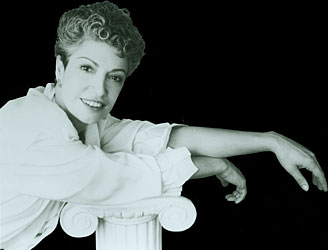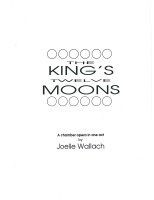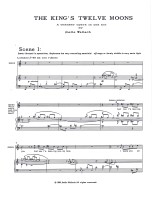King’s Twelve Moons: A Chamber Opera in One Act [40']
The King’s Twelve Moons is a lyrical and dramatic chamber opera, an adaptation of a folktale recorded by the Grimm brothers, the story of unwitting tyranny and the responses it evokes.
The plot involves a father who has lost his wife and who, fearing the loss of his daughters as well, keeps them locked in their room while he stands guard. Despite his vigil, they steal away each night, exuberantly dancing through the soles of their shoes. The music expresses the emotional and psychological facets of the story: love and grief twisted into overpowering possessiveness, the daughters’ responses to unreasonable authority, and the final triumph of the forces of exuberant life — a denouement different from the Grimms’.
Domination and disobedience, inadvertent cruelty and powerful love are forces which, though the medium of folk literature speak clearly to listeners. Lyrical, dramatic musical treatment focuses expressive power and infuses the story with meaning which is simultaneously relevant to children or to sophisticated adults.
The King’s Twelve Moons is scored for five singers, and either a piano reduction or an ensemble of chamber instruments. The string parts are written so that they can be executed by either single or sectional players. Thus, depending on the performers available, it is possible to expand the ensemble from 8 players to orchestral size or to reduce it to a single piano. The vocal scoring allows the four female singers who represent the daughters to be supplemented by silent performers or by additional singers as the remaining eight daughters and their secret beaux. Programs such as the increasingly popular opera‑in‑the‑schools could, with little preparation, use children in these non‑singing roles, and touring or regional companies could use community choral singers or local “supernumeraries.” This alternative scoring makes it possible to present The King’s Twelve Moons by small or larger companies, with few or many singers, with a large or small instrumental complement, and with simple or elaborate stage sets.
Opera is perhaps the principal genre of art music to which the general public is regularly exposed: on television and in the live performances of regional and touring companies and of operas-in-the-schools. Because of its appropriateness for adult or school audiences and because of its flexible requirements of instruments and singers, The King’s Twelve Moons can reach a large listening audience, some performances even involving some of the audience as participants. Bringing non-professionals into the performance of opera can stimulate interest in such music. Children or others who have been part of a production are more likely to become students and supporters of opera and of other art music as well.




